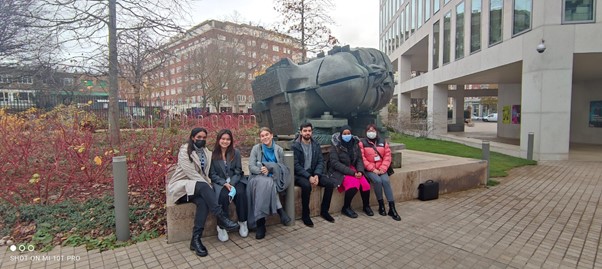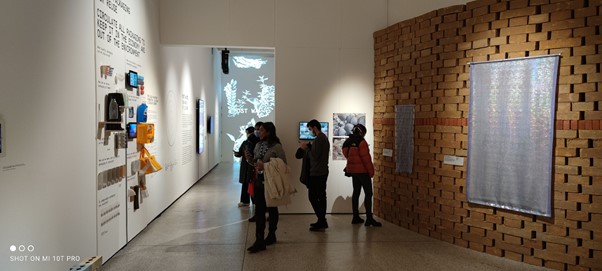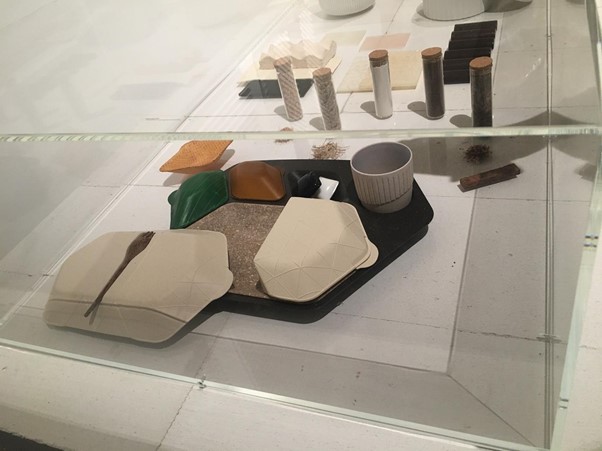Centre for Design and the Waste Age: A trip to the Design Museum
12/04/2022

In December of 2021, the C4D Design Thinking MDes team made their way to London, Kensington Park for an educational (but fun-filled and not to mention – covid-safe) trip to the Design Museum. It was essential to see in-person how designers integrate sustainable strategies and tools into their product development.
The week prior to the trip was intense. Guest speakers such as Ken Webster (International Society for Circular Economy), Joāo Murilo (Ellen McArthur Foundation), Ian Mckenzie (Trojan Energy Ltd), introduced not only the environmental applications but social and economic impacts that Circular Economy and the Cradle-to-Cradle standard can generate. It was safe to say we gained a lot of theoretical knowledge about whole system designs and all processes that are born from these theories. But does the theory actually translate to practice? Is there any impact on our everyday life?
Fast forward to a week later
The Design Museum introduced newfound sustainable products that had the potential to seamlessly glide into consumers’ lives.
Take aeroplane meal trays for instance. A hot main meal dish and lid is made of bamboo, a spork made of coconut wood and can be reused several times before it needs to be composted, a cover lid consisting of banana leaf and the base of wheat bran, a waffle-cone dessert dish and lid that is edible, the cup liner made of algae (biodegradable), and the tray is made of coffee grains mixed with lignin binder. Each material and process all reduce waste or eliminate waste from the design. As we walked around, we were inspired to think about our own roles as students, consumers and designers to encourage organisations to take a longer-term integrated view of their products and services. This is part of our responsibility to be able to influence certain decision making for policies like product life cycles or material selection.
The exhibition was called Waste Age: What can design do? and featured various winding rooms allowing audiences to explore products that we as consumers utilise in everyday life – from fashion, food, electronics, construction and packaging. The focus lies on waste – specifically “solid waste that is disposed of in landfill or through incineration” after the consumption or exhaustion of its purpose. The Waste Age reconsiders its re-usage to transform waste into resources again – closing the loop. Others may view re-usage as ‘one man’s trash is another man’s treasure.’
Seeing these objects out of the context of the home, isolated in its glass containers, and propped up on plinths sparked a certain tension that made us reconsider many options when it comes to their purpose and repurposes. We began to question whether there were alternative ways to fulfil the purpose this product was intended for; is it outdated?





Since most items were exhibited, we seemed to pay more attention to aesthetics such as shape, form and purpose but there was another more crucial dimension to consider. Its materials and environmental, social and economic effects upon the end of the product’s life cycle. For us consumers, it is unlikely we would think about its wider impact after we have binned a plastic cup.
A noticeable video installation (several old working TV monitors supported by wooden shelves) was presented by Ibrahim Mahama who used electronic waste using plugs, cords and other electronic components as his main materials. While for some, viewing these products was sentimental and familiar ‘back in my day…’, it was astounding to see that some of the televisions could still function as such since these products have come and been long gone, never to return to the homes of consumers.
Sadly, the reality of where these components were founded is more shocking. For instance, Accra, Agbogbloshie is the largest e-waste dump in the world and used by other countries to dump electronics. E-waste is incinerated or broken down by local workers to access metals inside – a dangerous process that leads to injury and illness.
Fortunately, change begins with a good design. Visionary designers are reinventing the relationship with waste – Formafantasma, Stella McCartney, The Ellen MacArthur Foundation, Lacaton & Vassal, Fernando Laposse, Bethany Williams, Phoebe English and Natsai Audrey Chieza. These works are encouraging to us as students to realise that change can only come with collaborations to do better not less bad.
At the end of the insightful journey, a fellow course mate and I were feeling quite parched. We reached the gift shop after exiting the exhibition and saw a vending machine with several small pouches of fruit juice packaged in edible plastic made of seaweed. While it may have literally felt like eating a plastic pouch, it was a new and exciting experience to find that the packaging was degradable whether it was tossed on the ground or broken down by our stomachs. It did make us think about how this could be introduced as a specific need for quick on-the-go thirst relief, especially if it were a juice that could provide a sugary energy boost. For instance, marathon runners could benefit from this product as they can be given this drink during their milestones. Overall, 10/10 for taste and sustainability!
Categories & Tags:
Leave a comment on this post:
You might also like…
Preparing your work for Turnitin submission
Before submitting your work into Turnitin for similarity checking, if you have used referencing software then you may need to take some important steps first. Mendeley and Zotero integrate with MS Word by embedding field ...
The fast track to supercar engineering: My Cranfield journey
It’s been a dream come true to work on some of the world’s most prestigious supercars – the Aston Martin Valhalla, McLaren 750 & Artura, the GMA T.33. But every successful ...
Automotive Engineering: From student to hypercar innovation at Rimac
We sat down with recent graduate Thomas Perrin, to discuss how his year on the MSc in Automotive Engineering at Cranfield University propelled him from the lecture hall directly into the ...
What this year at Cranfield really meant to me
Every Cranfield journey is unique. In this alumni reflection, Zachea Scicluna shares what her year at Cranfield truly meant, from facing uncertainty to gaining hands-on experience in industry-backed projects. I’ve been reflecting (and delaying) ...
Preparing for assignments and exams?
Sorry! We know it seems a bit mean to mention the exams in January rather than looking forward to the break before it! However, we know many of you will be thinking about your forthcoming ...
Screening for FTSE 100 companies on Bloomberg
So you’re researching an index and need some data on its constituent companies? Bloomberg’s Equity Screening tool makes light work of this, not just for the FTSE, but for indices, exchanges and sectors worldwide. Type EQS ...








